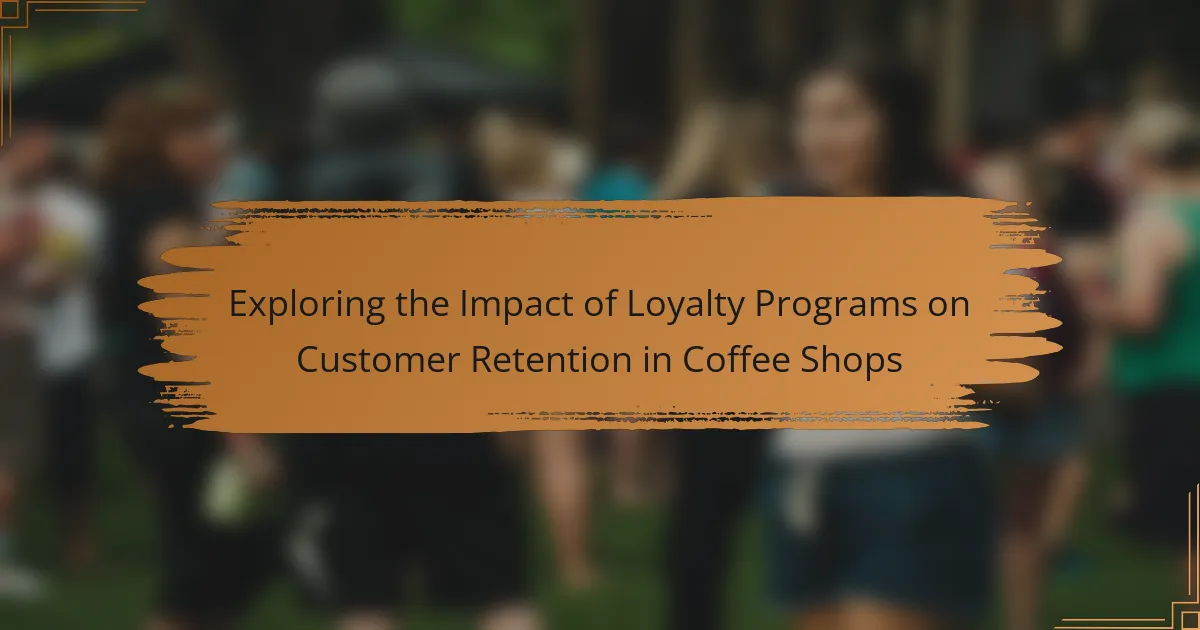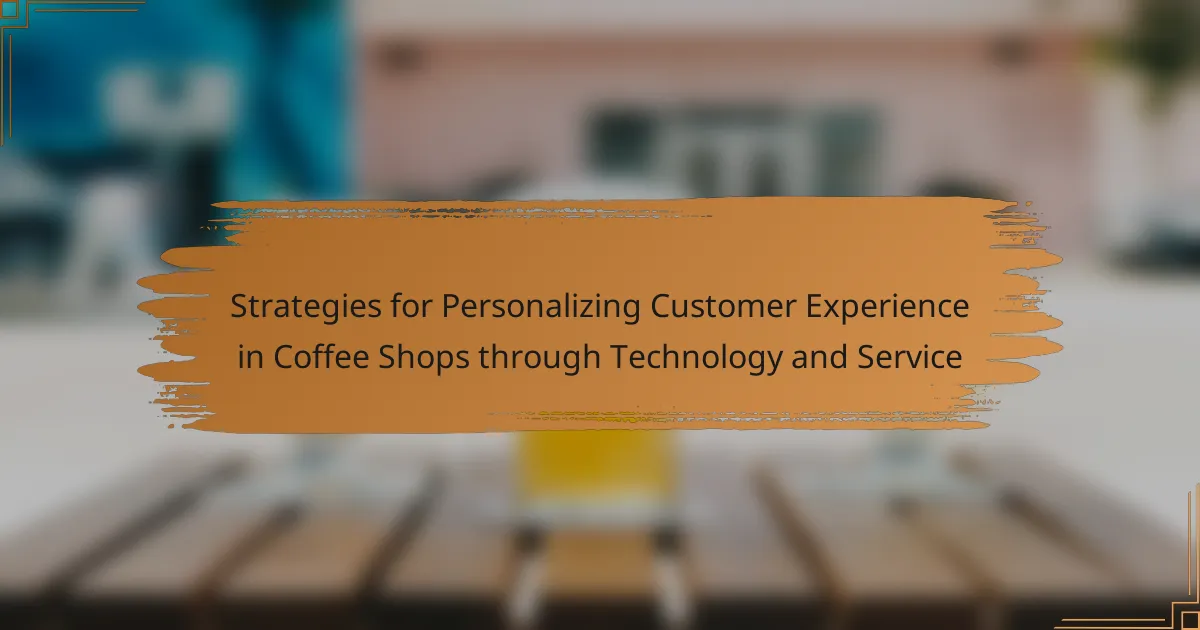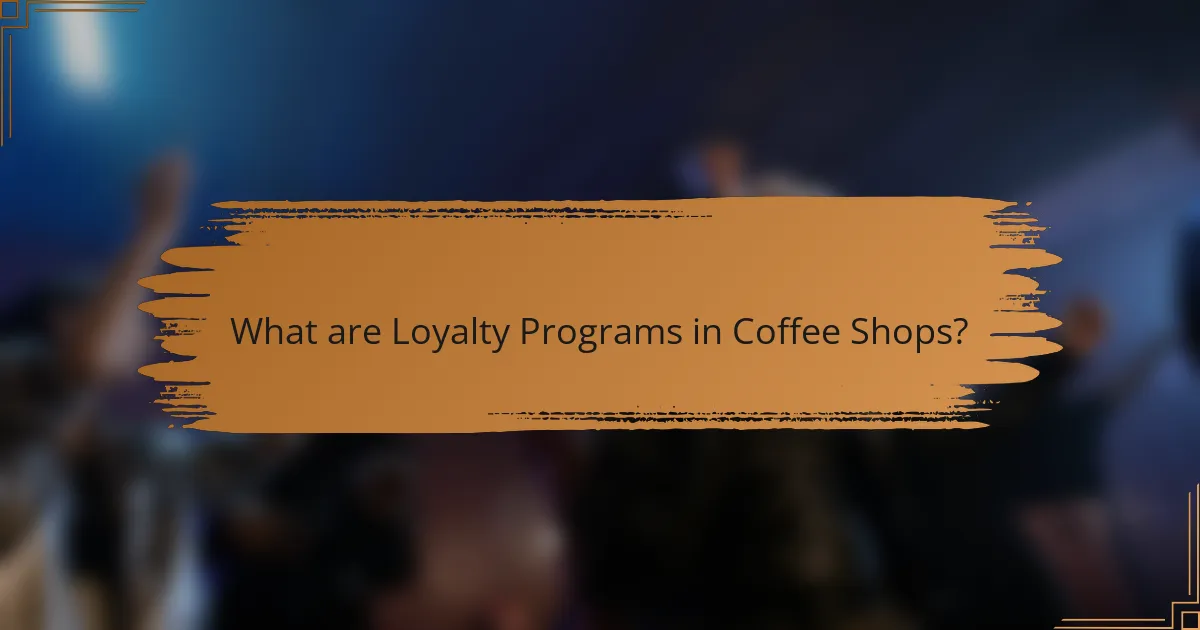
What are Loyalty Programs in Coffee Shops?
Loyalty programs in coffee shops are structured marketing strategies designed to encourage repeat business. These programs reward customers for their continued patronage through points, discounts, or free items. For instance, a coffee shop may offer a point system where customers earn points for each purchase. After accumulating a certain number of points, customers can redeem them for free drinks or other rewards. Research indicates that loyalty programs can increase customer retention by up to 20%. This retention is crucial for coffee shops, as repeat customers contribute significantly to overall sales.
How do Loyalty Programs function within the coffee shop industry?
Loyalty programs in the coffee shop industry reward customers for repeat purchases. These programs typically involve a point system where customers earn points for each purchase. Accumulated points can be redeemed for free items or discounts. Many coffee shops also offer tiered rewards, incentivizing higher spending for better benefits. Mobile apps are often used to track points and offer personalized promotions. Research shows that loyalty programs can increase customer retention by up to 20%. Customers feel valued and are more likely to return when they receive rewards. This creates a sense of community and brand loyalty among coffee shop patrons.
What are the key components of effective loyalty programs?
Effective loyalty programs consist of rewards, personalization, and engagement strategies. Rewards incentivize repeat purchases through discounts or points. Personalization tailors offers based on customer preferences and behaviors. Engagement strategies include regular communication and exclusive events to foster community. Research shows that 79% of consumers are more likely to engage with brands that offer personalized experiences. Additionally, effective programs utilize data analytics to refine strategies and improve customer satisfaction. These components work together to enhance customer retention in coffee shops.
How do loyalty programs track customer purchases?
Loyalty programs track customer purchases through digital systems that collect transaction data. These systems often utilize customer accounts linked to loyalty cards or mobile apps. When a customer makes a purchase, the transaction is recorded in the program’s database. This allows businesses to monitor spending patterns and purchase frequency. Data analytics tools then analyze this information to identify customer preferences. Additionally, many programs incentivize customers to share personal information for better tracking. This practice enhances the ability to tailor marketing strategies to individual customers. According to a study by Bond Brand Loyalty, 79% of consumers are more likely to engage with brands offering loyalty programs.
Why are Loyalty Programs important for Customer Retention?
Loyalty programs are crucial for customer retention because they incentivize repeat purchases. They create a sense of belonging and reward customers for their loyalty. This leads to increased customer satisfaction and brand loyalty. Studies show that loyal customers are more likely to make frequent purchases. According to research by Bain & Company, increasing customer retention by just 5% can boost profits by 25% to 95%. Additionally, loyalty programs can provide valuable data on customer preferences. This data allows businesses to tailor offerings and marketing strategies effectively. Overall, loyalty programs foster long-term relationships between coffee shops and their customers.
What impact do loyalty programs have on customer behavior?
Loyalty programs significantly influence customer behavior by encouraging repeat purchases. Customers enrolled in loyalty programs tend to spend more than non-members. According to a study by Bond Brand Loyalty, 79% of consumers say loyalty programs make them more likely to continue doing business with a brand. Additionally, loyalty programs foster a sense of belonging among customers. This emotional connection can lead to increased brand loyalty and advocacy. Research shows that customers who feel emotionally connected to a brand have a 306% higher lifetime value. Overall, loyalty programs effectively drive customer retention and enhance overall sales in coffee shops.
How do loyalty programs influence repeat visits to coffee shops?
Loyalty programs significantly increase repeat visits to coffee shops. These programs incentivize customers through rewards, discounts, or exclusive offers. Customers are more likely to return if they feel they are receiving value for their loyalty. Research indicates that 70% of consumers are more likely to choose a brand with a loyalty program. Additionally, loyalty members tend to spend 12-18% more than non-members. This increased spending is often driven by the desire to reach reward thresholds. Furthermore, loyalty programs create emotional connections with customers. This connection fosters brand loyalty and encourages repeat business.
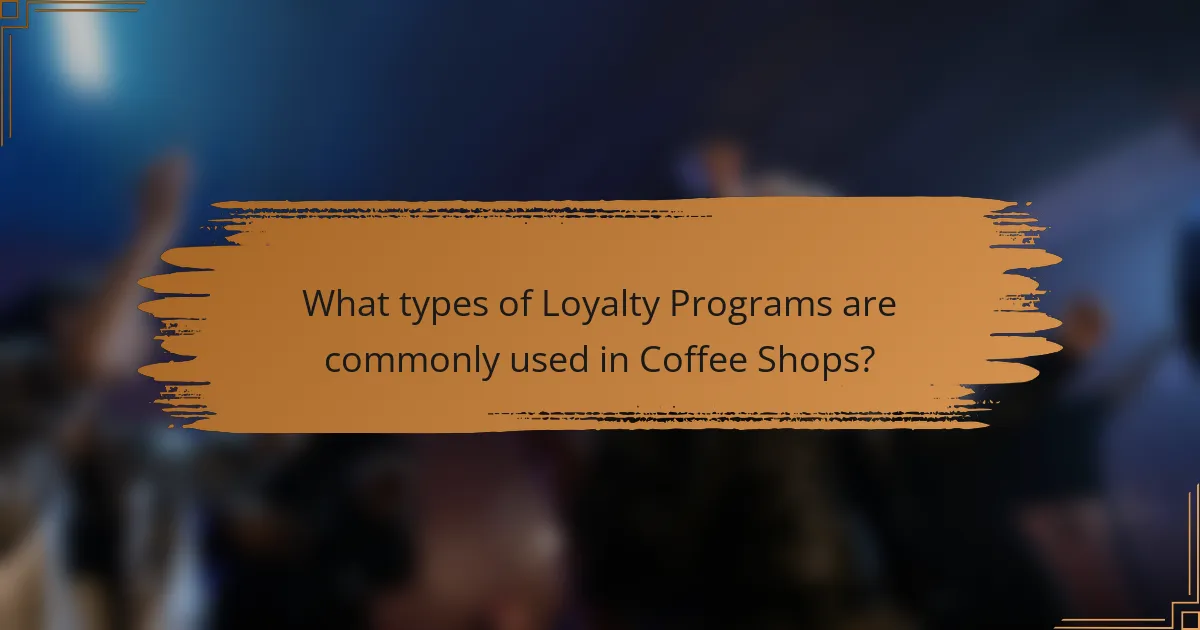
What types of Loyalty Programs are commonly used in Coffee Shops?
Common types of loyalty programs used in coffee shops include point-based systems, tiered rewards, and punch cards. Point-based systems reward customers with points for each purchase. Customers can redeem these points for free items or discounts. Tiered rewards offer different benefits based on customer spending levels. Higher tiers provide better rewards, incentivizing increased spending. Punch cards are simple and traditional. Customers receive a stamp for each purchase, earning a free item after a set number of stamps. These programs enhance customer retention by encouraging repeat visits and fostering brand loyalty.
How do points-based loyalty programs work?
Points-based loyalty programs reward customers for their purchases. Customers earn points based on the amount spent. Accumulated points can be redeemed for discounts or free products. For example, a coffee shop may offer one point per dollar spent. Once a customer reaches a certain number of points, they can exchange them for a free drink. This incentivizes repeat visits and increases customer retention. Research shows that loyalty programs can increase customer spending by 20%. Customers feel valued, which enhances their loyalty to the brand.
What are the advantages of points-based loyalty systems?
Points-based loyalty systems incentivize customer retention by rewarding purchases with points. Customers accumulate points for each transaction, which can be redeemed for discounts or free items. This structure encourages repeat visits, increasing customer lifetime value. Research shows that 83% of consumers are more likely to continue doing business with brands that offer loyalty programs. Points-based systems also enhance customer engagement through personalized offers based on purchasing behavior. Furthermore, they provide businesses with valuable data on customer preferences and spending patterns, aiding in targeted marketing strategies.
How do customers redeem points in these programs?
Customers redeem points in loyalty programs by exchanging accumulated points for rewards. This process typically involves selecting rewards from a catalog or menu offered by the coffee shop. Customers can often redeem points for free drinks, discounts, or exclusive items. Some programs may require customers to reach a certain point threshold before redemption is allowed. The redemption process is usually facilitated through a mobile app or in-store system. For example, Starbucks allows customers to redeem stars for free beverages after accumulating 150 stars. This system encourages repeat visits and increases customer loyalty.
What are tiered loyalty programs and how do they function?
Tiered loyalty programs are structured systems that reward customers based on their spending levels. These programs typically have multiple levels or tiers, each offering different benefits. Customers move up tiers by accumulating points or spending a certain amount. Higher tiers usually provide greater rewards, such as exclusive discounts or special offers. For example, a coffee shop might offer a basic tier with simple rewards and a premium tier with free drinks. This structure incentivizes customers to increase their spending to reach higher tiers. Research shows that tiered loyalty programs can enhance customer retention by creating a sense of achievement. This encourages customers to remain loyal to the brand for better rewards.
How do tiered systems motivate customers to spend more?
Tiered systems motivate customers to spend more by creating a sense of progression and reward. Customers perceive increased value as they reach higher tiers. This perception encourages additional spending to unlock better rewards. For instance, a coffee shop may offer a free drink after every 10 purchases. Customers may be inclined to buy more frequently to achieve this goal. Research shows that loyalty programs with tiers can increase customer spending by up to 20%. This increase is attributed to the desire to attain higher status within the program. Thus, tiered systems effectively drive customer behavior towards greater expenditure.
What are the potential drawbacks of tiered loyalty programs?
Tiered loyalty programs can create barriers for customers. These programs often require customers to reach higher spending thresholds for rewards. This can discourage participation from lower-spending customers. Additionally, customers may feel frustrated if they perceive rewards as unattainable. Complexity in understanding the tiers can lead to confusion. Customers might not engage fully if they do not grasp how to earn rewards. Furthermore, tiered systems can lead to inequity among customers. Those at lower tiers may feel undervalued compared to higher-tier members. According to a study by Accenture, 42% of consumers feel loyalty programs do not meet their expectations. This indicates a potential disconnect between program design and customer satisfaction.
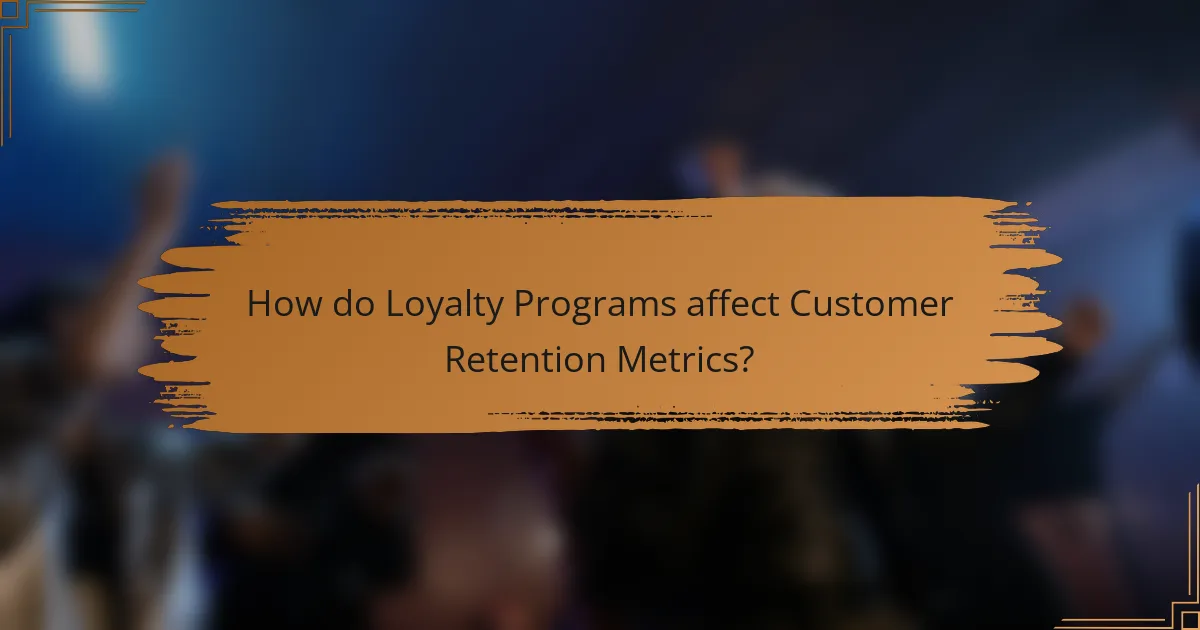
How do Loyalty Programs affect Customer Retention Metrics?
Loyalty programs significantly enhance customer retention metrics. They incentivize repeat purchases through rewards, discounts, and exclusive offers. This creates a sense of belonging and encourages customers to return. Studies show that customers enrolled in loyalty programs spend 12-18% more than non-members. Additionally, loyalty programs can increase customer lifetime value by fostering long-term relationships. For instance, a 2020 study by Accenture revealed that 77% of consumers are more likely to stay with brands that offer loyalty rewards. This demonstrates that effective loyalty programs directly correlate with improved retention rates in coffee shops.
What metrics are used to measure the success of loyalty programs?
Key metrics used to measure the success of loyalty programs include customer retention rate, average transaction value, and frequency of purchases. Customer retention rate indicates the percentage of customers who continue to engage with the program over time. Average transaction value reflects the monetary amount spent by customers during their visits. Frequency of purchases tracks how often customers make transactions within a specific timeframe. Other important metrics are enrollment growth rate and redemption rate. Enrollment growth rate measures how quickly new members join the loyalty program. Redemption rate indicates the percentage of rewards that customers actually redeem, showing program engagement. Together, these metrics provide a comprehensive view of loyalty program effectiveness in enhancing customer retention.
How can coffee shops analyze customer retention rates?
Coffee shops can analyze customer retention rates by tracking repeat purchases over time. They can utilize point-of-sale systems to gather data on customer transactions. Analyzing this data reveals patterns in customer behavior. Coffee shops can also implement loyalty programs to monitor customer engagement. By evaluating the frequency of visits and purchase amounts, they can assess retention effectiveness. Surveys can provide additional insights into customer satisfaction and preferences. Industry studies indicate that a 5% increase in customer retention can lead to a 25-95% increase in profits. Therefore, consistent analysis of these metrics is crucial for improving retention strategies.
What role does customer feedback play in assessing loyalty program effectiveness?
Customer feedback is crucial in assessing loyalty program effectiveness. It provides insights into customer satisfaction and engagement levels. Feedback helps identify what customers value most in a loyalty program. This information can guide improvements and enhancements to the program. For instance, a study by Accenture found that 83% of consumers are willing to share feedback if it leads to better services. Additionally, analyzing feedback trends can reveal patterns in customer behavior and preferences. This data is essential for optimizing rewards and communication strategies. Overall, customer feedback directly influences the success and relevance of loyalty programs.
How can coffee shops enhance their loyalty programs to improve retention?
Coffee shops can enhance their loyalty programs by personalizing rewards and improving customer engagement. Personalized rewards increase customer satisfaction and retention rates. For instance, offering tailored discounts based on purchase history can encourage repeat visits. Additionally, integrating mobile apps for easy tracking of rewards fosters convenience and engagement. Research shows that 70% of customers are more likely to return if they feel valued through personalized experiences. Implementing tiered loyalty systems can also motivate customers to reach higher levels for better rewards. This strategy effectively boosts customer loyalty and retention.
What best practices should coffee shops follow when designing loyalty programs?
Coffee shops should implement a points-based system for their loyalty programs. This approach encourages repeat purchases by allowing customers to accumulate points for each transaction. Offering tiered rewards can enhance customer engagement. Different levels of rewards motivate customers to reach higher tiers. Personalization of rewards based on purchase history increases relevance. Tailoring offers to individual preferences can boost customer satisfaction. Regular communication through emails or app notifications keeps customers informed about their points and rewards. Research indicates that 70% of consumers are more likely to engage with brands that provide personalized experiences. Additionally, integrating social media sharing can enhance visibility and attract new customers.
How can technology improve the efficiency of loyalty programs?
Technology can enhance the efficiency of loyalty programs through automation and data analytics. Automation streamlines processes such as point accumulation and redemption. This reduces errors and saves time for both customers and staff. Data analytics allows businesses to track customer behavior and preferences. This enables personalized offers and targeted promotions, increasing customer engagement. According to a study by McKinsey, personalized marketing can lead to a 10-30% increase in sales. Additionally, mobile apps facilitate easy access to loyalty rewards. This convenience encourages more frequent customer visits. Overall, technology optimizes operations and enhances customer satisfaction in loyalty programs.
What are some common challenges faced by coffee shops with Loyalty Programs?
Coffee shops face several common challenges with loyalty programs. One major issue is program complexity. Customers may find it difficult to understand how to earn and redeem rewards. This confusion can lead to frustration and disengagement. Another challenge is low customer participation. Many customers may not see the value in joining a loyalty program. This can result in underutilization of the program. Additionally, coffee shops may struggle with tracking customer data effectively. Inaccurate data collection can hinder personalized marketing efforts. Another challenge is maintaining program relevance. Loyalty programs must evolve to meet changing customer preferences. Finally, financial sustainability is a concern. High reward costs can eat into profit margins. These challenges require careful planning and management to ensure program success.
How can coffee shops address customer disengagement with loyalty programs?
Coffee shops can address customer disengagement with loyalty programs by personalizing rewards and improving communication. Personalized rewards cater to individual preferences, enhancing customer satisfaction. For instance, offering tailored discounts based on purchase history can increase engagement.
Improving communication involves regularly updating customers about loyalty program benefits. Clear messaging about how to redeem rewards fosters participation. According to a study by Accenture, 83% of consumers are more likely to engage with brands that personalize experiences.
Additionally, simplifying the reward redemption process can reduce frustration. A seamless experience encourages customers to utilize the loyalty program more frequently. Implementing feedback mechanisms allows coffee shops to understand customer needs and adjust their programs accordingly. This responsiveness can significantly enhance customer loyalty and retention.
What strategies can be implemented to keep loyalty programs fresh and appealing?
To keep loyalty programs fresh and appealing, coffee shops can regularly update rewards and offers. Introducing seasonal promotions can create excitement and encourage repeat visits. Incorporating personalized rewards based on customer preferences enhances engagement. Offering exclusive experiences, such as members-only events, can increase perceived value. Implementing gamification elements, like challenges or tiers, motivates customers to participate more actively. Regularly soliciting customer feedback helps identify areas for improvement. Monitoring industry trends ensures the program remains competitive and relevant. These strategies collectively contribute to maintaining customer interest and loyalty over time.
What practical tips can coffee shops use to maximize the impact of Loyalty Programs?
Coffee shops can maximize the impact of loyalty programs by personalizing rewards. Tailoring offers to individual customer preferences increases engagement. Implementing a tiered rewards system encourages higher spending. Customers are motivated to reach new levels for better rewards. Frequent communication through email or mobile apps keeps customers informed. Regular updates about points and rewards enhance program visibility. Offering exclusive promotions for loyalty members creates a sense of belonging. Studies show that personalized experiences can increase customer retention by 10-15%. Lastly, collecting feedback on the loyalty program helps coffee shops improve and adapt offerings.
Loyalty programs in coffee shops are structured marketing strategies that incentivize repeat business through rewards such as points, discounts, and free items. This article explores their functionality, key components, and impact on customer retention, highlighting how effective loyalty programs can enhance customer satisfaction and drive sales. It also examines various types of loyalty programs, including points-based and tiered systems, and discusses metrics for measuring their success. Additionally, the article addresses common challenges faced by coffee shops in implementing these programs and offers strategies for maximizing their effectiveness and maintaining customer engagement.
